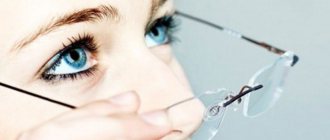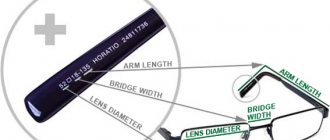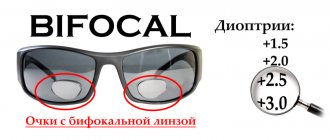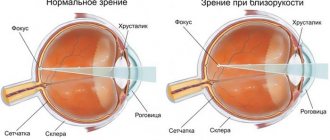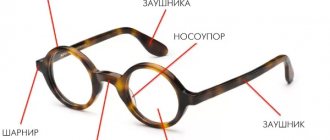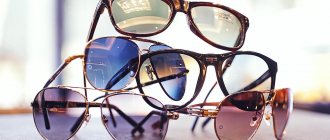Three questions are usually asked about prescription lenses: “What’s so special about them?”, “Why are they so expensive?”, and then, “Why do I see and feel so amazing in them?” There is one answer to all these three questions.
- First step. Vision diagnostics and frame selection
- Second step. Factory work with care for nature
- Third step. Returning to the salon and “setting up” the picture
Most often, three questions are asked about prescription (individual) lenses: “What’s so special about them?”, “Why are they so expensive?”, and then – “Why do I see and feel so amazing in them?” It turned out that there is one answer to all three questions: innovative digital technologies are used in their production. It’s easy to see this if you see step by step the process of creating individual lenses.
What are they made of?
Lenses are made of glass or optical polycarbonates.
Important! Each material has a number of advantages and disadvantages.
Glass has a higher hardness and, as a result, is highly resistant to scratches and chemical-thermal effects. The downside will be high fragility (a piece of glass near the eye is not the brightest prospect for a bespectacled person) and greater weight compared to plastic. The latter is light, durable, easier to process and cheaper.
First step.
Vision diagnostics and frame selection
The birth of a prescription lens begins in the optometrist's office: this specialist conducts standard vision diagnostics and identifies the structural features of the eye. It is individual for each patient: there are no two identical eyes in the world, and all people without exception have refractive errors.
The birth of a prescription lens begins in the optometrist's office
The most common of them are myopia, hypermetropia and astigmatism. In addition, each eye has an "aberration" - an error or error in the image in the optical system, which also prevents people from seeing well. After a thorough diagnosis, the optometrist writes a prescription for lenses with all the features of this optical system. So, today a patient can be given a prescription in increments of 0.12 diopters. This became possible quite recently, and not all manufacturers can adapt to such requirements: for example, now a prescription may indicate 0.62 diopters, but previously the doctor had to decide whether to prescribe glasses for 0.5 or 0.75 diopters, choose "many or few".
The prescription for lenses for patients with astigmatism also has its own peculiarity: in it, in addition to the sphere, it is necessary to indicate the cylinder (that is, the difference between the meridians) and the position of the axis - it falls within the range from 0 to 180º in increments of 1º. As a result, the position of the meridian may be equal to 52, that is, it is not always a round number. Almost all lenses for patients with astigmatism are prescription lenses. Next, based on the prescription, the consultant in the optical salon selects the frame, fills out a special form for the manufacture of lenses and sends it to the manufacturer's factory.
Convex, concave, what else?
Based on their shape, lenses are divided into spherical and aspherical. Spherical (single-focal - with one focus) have one grounding curve and are divided into:
convex - to correct farsightedness;- concave - for myopic people.
Aspherical ones are thus designed to correct the astigmatism defect and have more grounding curves. There are also bifocal subtypes, which are divided in half - for working at a long distance and near, which is convenient with the onset of age-related changes. Progressive ones, in turn, have three surface areas - for long, medium and short distances.
Keep your eyes open: how to make money from a network of opticians and your own eyewear brand
Olga Shcherbakova from Voronezh is a hereditary entrepreneur. Her family's wealth of knowledge and skills led her to create her own network of opticians. At some point, she decided to go further by launching her own brand of glasses - and in this field she also achieved success: now glasses are sold not only in her opticians, but also in other chains throughout the country. Olga Shcherbakova spoke in an interview with Biz360.ru about how to make money from a network of opticians and her own brand of glasses.
Dossier
Olga Shcherbakova
, 36 years old, entrepreneur from Voronezh, founder of a chain of opticians and a brand of glasses. By education - information systems engineer, graduated from Voronezh State University; also holds an MBA degree. In 2007, she launched the online store of contact lenses “Optics of the Century”, in 2008 she opened the Visio optical chain (now it includes seven salons in Voronezh and Lipetsk), and in 2021 she launched her own brand of glasses. It is also developing a network of beauty salons.
How it all began
After graduating from university, I worked for 1.5 years as a 1C programmer - this is a person who sees different businesses from the inside. It's hard not to want to open your own one day. Plus, my mother is an entrepreneur, she had her own medical business. Before that, she worked as a teacher of cutting and sewing courses and sewing, and I helped her from the age of 7. So, from the age of 18, I seriously thought about my business.
My mother-in-law helped me with the idea. She often complained that she was very tired in the optician where she worked: there was always a line there. And we came up with an idea: since there is such a demand for contact lenses, maybe we should try selling them online? Moreover, at that time they were sold in only two offline locations in Voronezh.
In 2007, we launched an online store - and people came. At first, only those who already had an understanding of what lenses they needed. And then people started asking for help with choosing lenses. And already in 2008 we bought the premises for the first optics.
It is difficult to overestimate the importance of family in this project. My mother-in-law helped me a lot at the start with her knowledge, and then as an experienced sales director. In addition, she organized our staff work. My mother suggested to me the specialists who were involved in certification. My husband is a doctor who was studying a lot at the time and could not actively participate in the project, but still helped as much as he could; Today he runs medical centers, and we have a joint diversified enterprise with him.
That is, I have a family that collectively had all the competencies to open such a business. And although I am leading the project, it is more of a family affair. Starting something in such an area without such support would, of course, be much more difficult. The industry is specific. Not everyone will go into it.
Everything is “grown-up”
We opened not just points selling lenses and glasses, but opticians with medical offices. They require medical professionals who specialize in ophthalmology or optometry (this is a secondary medical education). We try to have both specialists working in our optics.
Accordingly, a medical license was needed to work in order to comply with the standards of Rospotrebnadzor and Roszdrav on lighting, equipment and other characteristics. That is, to open it, a gigantic package of documents is required, which takes three months to collect.
I note that many opticians in Russia work without a medical office. They declare themselves as an enterprise that does not provide services for the selection of vision correction products - only the products themselves. But this, of course, is a semi-legal story. I believe that our clients should receive from us solutions to various problems with vision diagnostics.
In terms of finance, our start was a credit history. Firstly, I borrowed about 1.5 million rubles from my mother for repairs. Secondly, it was necessary to buy the premises, so I had to take out two more loans of 4 million rubles each.
The premises for the first salon were inexpensive, because the building we chose had an inconvenient entrance and heavy tenants - and the owner was about to leave.
We were also lucky that at that time the suppliers agreed to a six-month deferment in payment - the market was just emerging. Nowadays such conditions cannot be found. The purchase of the first batch cost us approximately 1 million rubles. And then there were also 1.5 million for each point.
The demand in the first optics turned out to be as good as in the online store. It quickly gained good momentum, so we paid off all our debts quite easily.
Your own space is better
Three of our six Voronezh locations are owned. I borrowed this strategy from my mother, and it proved to be especially advantageous in difficult conditions - during quarantine.
For example, one of our landlords is a very loyal entrepreneur to us, and he made concessions during the period of self-isolation. But the second one is a person who does not have his own business and who did not understand why I should not pay 100% of the rent during quarantine. As a result, our salons on our own premises, of course, survived the difficult period much better than those that were rented.
Of course, there are also advantages to opening outlets in rented space in shopping centers: it is thanks to them that we are mainly recognized as a brand. You also need to keep in mind that one of our points is located in Lipetsk - I simply didn’t know the market well enough to buy anything. However, I am sure that our own areas are better.
Before the pandemic, we were going to open our first showroom in Moscow. This is probably not so true today: people have mostly switched to online orders. Therefore, for now they have slowed down the opening in the capital.
For ladies - “cats”, for men - “squared”
When we first started working, I went to other opticians and noticed that all the glasses there had some kind of dark frames. I decided to stand out and buy something lighter and brighter (I recently read that many new opticians do this).
At that time, it was rather a mistake - it turns out that the Russians liked darker glasses. We sold what we purchased then, but later we began to buy more of the darker assortment. But now this trend has gone away, people began to ask, on the contrary, for something bright and light.
For women, we always sell glasses with wide frames and an emphasis on the upper part (such models are called “cats”). Round glasses have also become in demand, but they do not suit all Russian ladies.
If we talk about men, in Russia they never choose round glasses, even if it obviously suits them - only “squared” models. Here, of course, there is a stereotype that cannot be explained rationally: “I’m a man, I won’t wear round glasses.” There is no such thing in Europe.
Especially for Russians
In 2021, we noticed that there is almost no good range of glasses on the market in the segment between premium and economy. Then it was decided to develop our own brand. I went to China to factories and selected the necessary models. Then I resolved the issue with documents, since frames are medical products and require special documentation. The result is our brand Oliver WOOD.
There are many factories in China that make glasses. But there are very few quality workers. Therefore, today our products are produced in only one production facility.
I immediately decided that we would not introduce ourselves as an Italian brand, being in fact “China”. No, we decided to position ourselves as a Russian brand with high-quality production in China.
In addition to honesty, there is also a nuance here: European brands are not at all adapted to Russian faces. Therefore, glasses that look good on Europeans often do not fit well on our compatriots. Russian faces are wider and have Asian cheekbones; while Europeans have “long”, elongated faces, and completely different frames look good on them. It is often even uncomfortable for us to wear them, because such glasses squeeze the temples - they are so narrow.
We wanted to offer something of high quality and made specifically for Russians. Today, at one of our outlets there are about 700-1000 types of glasses, and Oliver WOOD occupies about 30% of this number and is the sales leader. Not because we advertise it more - it sells well in third-party optics too. The fact is that this brand simply really suits Russians.
At first, it was difficult for our glasses to be accepted by other networks - after all, the conservative environment makes itself felt. However, after my presentations at specialized conferences and exhibitions, our products began to attract more and more interest. Now our glasses are taken to the shelves quite willingly.
We do not plan to increase the share of our brand in our salons. 25-30% is the optimal amount. People should have a choice, because at their own facilities it is unprofitable to produce such a wide range that other brands provide. And we already produce our own brand of glasses in fairly large volumes - in batches of 5 thousand pieces.
New time - new advancement
When we entered the market, promotion, of course, was completely different from what it is today. Back then, the standard was primarily active SEO. We also advertised on various portals, used outdoor advertising, called customers, etc. Now the share of online activities has become much larger (these are specialized medical platforms plus targeted advertising), and offline we are now practically not represented at all.
Recently, I have also begun to promote not only my company, but also to develop a personal brand. Among doctors, reputation is extremely important; Although I am not a doctor, I understand the importance of image. It helps to find qualified employees in the first place.
We recently revised our USP, since competition has grown greatly over the years since our launch and many people today sell contact lenses with glasses. We have added such a feature as an optical style consultant - when glasses are selected for people not only from an ophthalmological point of view, but also from a style point of view. For this purpose, in the spring I developed a special training course for employees.
For now, we implement it only in our optics. In the future we plan to launch it in salons in other cities. Today our glasses are sold by 70 partners in 25 cities across the country.
Creative opticians
Few Russian opticians make their own brand of glasses for the wide market - only about three. The rest do this mainly for their own needs, without selling products in other networks. If we talk about competition in general, we have several strong competitors, each of them has its own advantage. One of them dumped for quite a long time, but today they have already realized that this strategy is unprofitable.
There is also one federal competitor that is aggressive in terms of development - "Happy Look" from St. Petersburg (each region has its own - in Nizhny Novgorod, for example, the federal network "Kronos" very strongly suppressed local ones). However, in general the market is balanced, everyone finds their niche.
When I started, I was a very young entrepreneur among the seventy-year-old founders of other opticians. The main development strategy of these people who grew up in the 90s was to strangle the competitor. However, it was good to work with them in the same market - they were inflexible. This gave a great advantage.
Today, a new generation has grown up that has creative thinking. Its representatives open interesting projects. For example, I really liked one example from Chelyabinsk: there they made optics in the format of an art space. A very non-standard approach.
We have worked hard for the service for years, so, to be honest, I am 100% confident in our services. Everyone who works for us learns constantly and a lot. Training for a new employee lasts two months. For the first two weeks, a newbie just sits and reads our training portal. Then he goes to the curator and practices new knowledge with him. So, overall, we took a fairly confident position. In the future, I plan to expand my geography (primarily for Oliver WOOD) and work to strengthen the brand.
In order not to miss an interesting and useful article about small business for you, subscribe to ours
, and .
biz360biz360
Types of lens coatings
Important! Plastic lenses can be given more useful properties by applying various coatings.
from exposure to cleaning materials and hard objects.
The impact-resistant coating compensates for the original softness of the plastic and increases its resistance to scratches.- Anti-reflex (brightening) - improves image clarity, neutralizes glare from the outside and inside.
- A hydrophobic (water-dirt-repellent) layer is obtained by applying the thinnest silicone film, from which water and dirt roll off ( the effect of “glasses fogging” disappears when moving from a cold to a warm room ).
- The antistatic coating eliminates the possibility of a static charge arising from contact with skin and various tissues, which attracts dust (removing it scratches the surface of the glasses).
- Multifunctional - includes 4 of the above coatings.
- Mirror application has only an aesthetic function; it makes the eyes indistinguishable behind lenses of different shades.
Glass lens production technology
The principle of lens production has remained virtually unchanged since the invention of glasses; processing accuracy has improved, manufacturing time has decreased and the process has become automated.
A blank (about 10–14 cm) is taken as a basis, and the number of its diopters is measured with a special device.- The next step is to scan the glasses frame in order to match the frames and lenses, then they will be aligned without additional adjustment.
- Then the lens is placed in an automatic machine, where the required shape is given by grinding with the necessary force (during the entire grinding stage, its surface is washed with an aqueous solution with aluminum particles for cooling, removal of removed particles and a more effective effect of the grinding material on its surface).
- Before fitting into the frame, its edges are additionally ground to obtain the required chamfer.
Frame
First, the frame is selected. The choice depends entirely on your budget and preferences, but it is worth considering in advance that some types of lenses will not fit into some frames.
After the frame is selected, the master will remove the false lenses from it and place them on the sharpening machine. The equipment will “remember” the shape and size of the glass, according to which the specialist will grind the lens and install it in the future frame.

